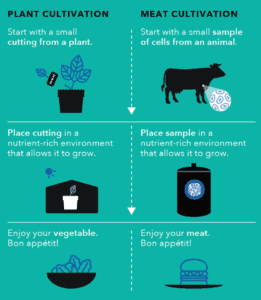Food security and supply is a big focus for the city-state of Singapore. With big goals set for Singapore’s food story by 2030, is lab-grown/cell-based/cultured meat the answer? Here are Green Monday’s thoughts about the future of food.
Barren supermarket shelves and snaking lines became a global phenomenon as panicked shoppers emptied supermarkets in light of COVID-19 lockdowns. For many of us, this was a shocking sight and a startling reminder of how much we take our food for granted. Furthermore, as a tiny island nation, Singapore imports a whopping 90% of its food supply and thus is vulnerable to ripple effects of climate and economic calamities. With border closures and supply chains disrupted by the pandemic, the issue of food security was once again brought into the spotlight.
The narrative of our Little Red Dot lacking resources has been a recurrent theme since independence in 1965. Hence, our leaders are always thinking and planning two steps ahead. In April 2019, the local government founded the Singapore Food Agency, announcing the ‘30 by 30’ Plan to decrease our reliance on imports and increase Singapore’s food security goal through science and technology.
One of our solutions: Lab-grown meat.
Singapore made history in December 2020 when it became the first country in the world to approve the sale of lab-grown meat (a.k.a cultured meat or clean meat) by San Francisco Startup, Eat Just Inc under the GOOD Meat brand. The lab-grown meat comes in the form of chicken, and will be launched commercially as nuggets or ‘chicken bites’. But what is it exactly and how is it produced?

Infographic via The Good Food Institution
The concept of lab-grown meat is similar to that of plant cultivation. It starts with a sample of animal cells which are extracted and placed in a solution ‘broth’ of broken-down nutrients. They then undergo a cultivation process in a bioreactor to multiply, forming connective tissue in a controlled environment. Compared to the 45 days it takes to raise a chicken to meat maturity, the lab process is more efficient, only requiring 10-14 days.
Globally, an average of 60 billion chickens are slaughtered every year for consumption and this trend is expected to increase with growing populations. In Singapore alone, the production of chicken accounts for the second-highest source of greenhouse emissions from food. Lab-grown meat not only addresses issues of animal cruelty, sustainability, and food security, it is also clean — free of antibiotics and harmful microbials.
Nevertheless, to call a spade a spade, lab-grown meat is still very much animal meat and therefore not suitable for vegans and vegetarians. There are also implications for the poultry industry as can be seen with dairy farmers in the United States. Furthermore, there is the issue of affordability in comparison to regular meat. In the case of Shiok Meats, their 2019 prototype of lab-grown lobster meat cost USD7000/kg. This issue of commercial viability is faced by startups across the board, it will take time to improve their technology and scalability to reach an affordable price for consumers.

Image credit: 1880 & Eat Just
Putting lab-grown meat to the taste test
While lab-grown meat sounds like a science fiction work-in-progress, it has already landed on our tables.
We had the opportunity to sample the world’s debut of GOOD Meat cultured chicken at their launch event at restaurant 1880. Like many guests, we were both marvelled by the science and delighted that it still looks, smells and tastes like good ol’ chicken. In fact, some of the guests joked with the chef asking if he had nipped out to the supermarket to buy real chicken for the dishes. Comparing this to plant-based meat, lab-grown meat is certainly the closest alternative.
Here, GOOD Meat’s cultured chicken are offered in a trio of sample dishes: bao bun with crispy sesame cultured chicken and spring onion; phyllo puff pastry with cultured chicken and black bean puree; and a crispy maple waffle and cultured chicken with spices and hot sauce. Priced at SGD23, the sampler trio is on par with a regular chicken dish at the establishment.
Can lab-grown meat emerge as the ‘new normal’?
The future of lab-grown meat certainly seems bright. It checks many of our boxes to feed our growing appetites while solving issues of sustainability and food security. Many of the cultured-meat startups such as Memphis Meats and Future Meat Technologies have attracted millions of dollars in series A funding and the industry is forecasted to reach $130 billion by 2030. In Singapore, other contenders such as Shiok Meats are not far behind, working towards the launch of lab-grown lobster meat in 2022.
Yet despite all the hype, how exactly will the public take to lab-grown meat replacing their favourite fried chicken or the iconic Hainanese Chicken Rice? There is definitely an ‘ick’ factor and foreseeable skepticism toward the technology. But as observed in the growing openness and rising demand for alternative meat/dairy products, there is certainly hope for lab-grown meat, only time will tell.
